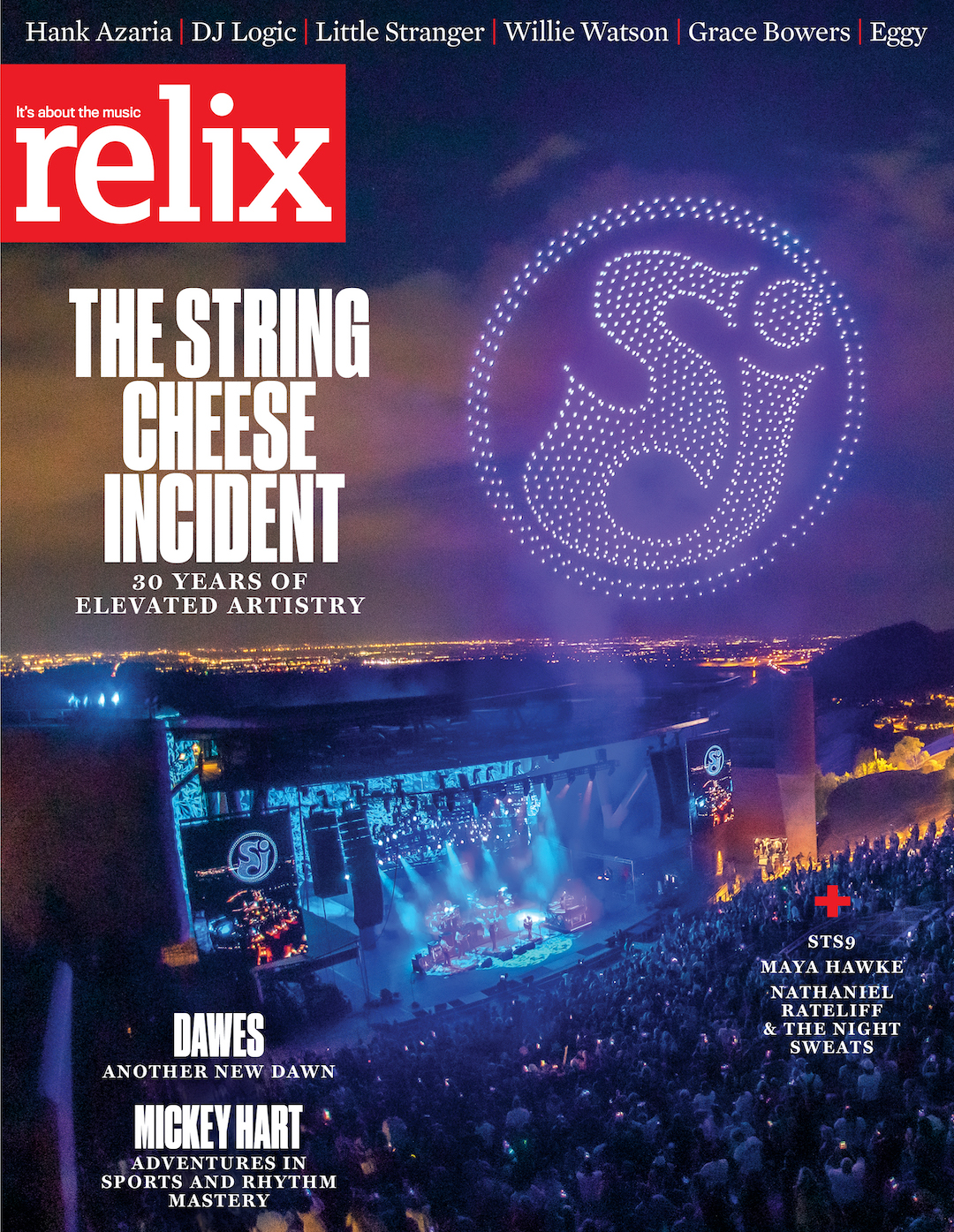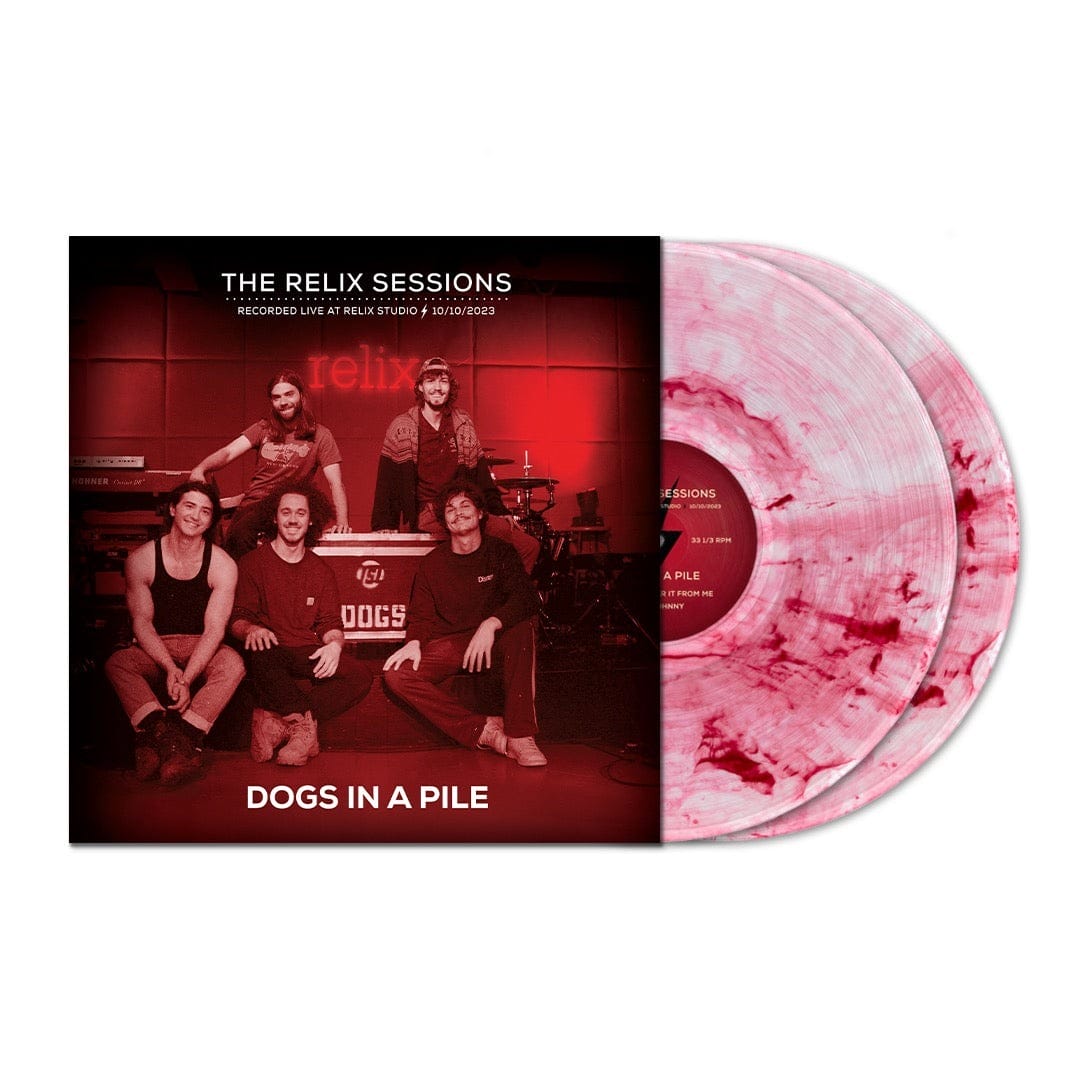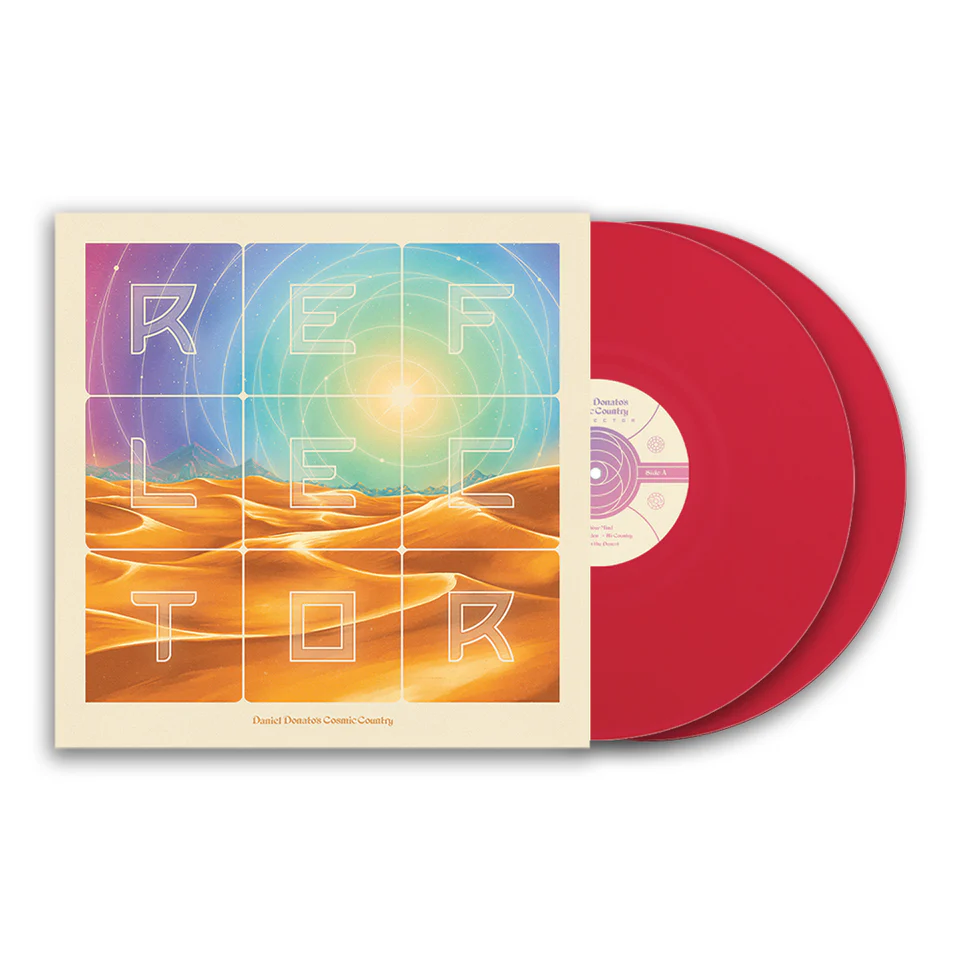Goose: The Journey Is The Destination
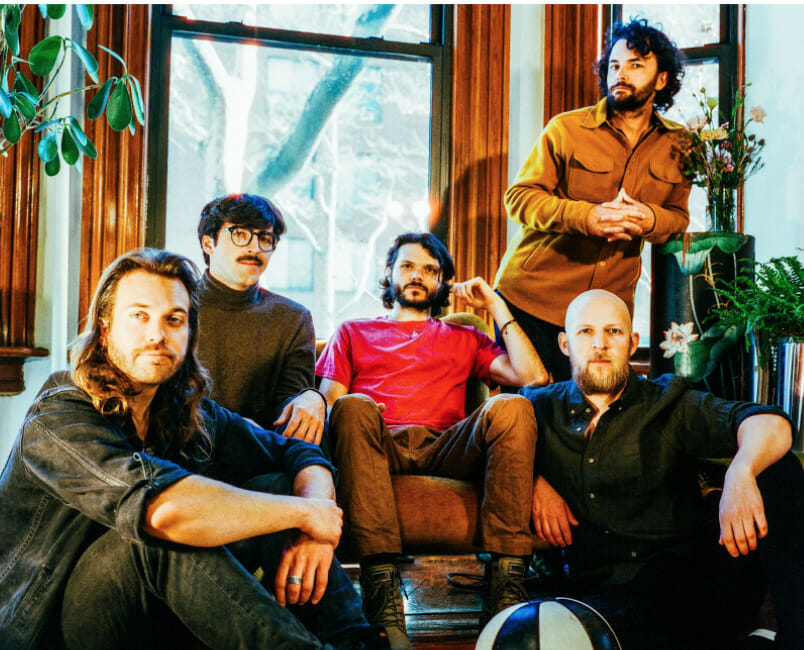
photo credit: Pooneh Ghana
***
“I’m a bit of an escapist” Goose guitarist/vocalist Rick Mitarotonda says of the approach that informs his creative expression. “I like make-believe. I’m drawn to stories, sci-fi and magic. That’s what I’m chasing. In the band, we talk about suspension of disbelief a lot. That’s a huge thing to me. My suspension of disbelief is pretty fragile, and there’s a lot that kicks it out. There is so much about the modern world that dampens my inspiration.”
Yet, it is also this perspective that draws the modern world ever-closer to Mitarotonda and his fellow members of Goose. The group’s penchant for exploring and exhibiting an unfettered musical imagination increasingly resonates with new fans.
In February, Goose blew out its first-ever arena show, a COVID-delayed Goosemas celebration at Mohegan Sun in the band’s home state of Connecticut. This performance followed the group’s spirited Fred: The Festival at LOCKN’ Farm in Arrington, Va. this past August, as well as two dynamic year-end gigs at the Riviera Theatre in Chicago.
On June 24 and 25, the quintet—which also features Peter Anspach (vocals, keys, guitar), Trevor Weekz (bass), Ben Atkind (drums) and Jeff Arevalo (vocals, percussion, drums)—will take the stage for two nights at the illustrious Radio City Music Hall. In mid-January, the group announced that they would perform three sets—one acoustic and two electric—at the renowned venue, then added a second date shortly afterward due to overwhelming ticket demand.
The Radio City shows assert Goose’s prominent position within the contemporary jamband firmament.
However, they also serve as a signpost of what prompted the band’s ascent: June 24 marks the release date of the group’s new studio album, Dripfield. While the five members of Goose are adept improvisers and inventive artists, whose artistic output often extends beyond the concert stage, at the core of their allure is an affinity for singing and songcraft.
***
In June 2021, Goose released Shenanigans Nite Club, their second album—the follow-up to 2016’s debut, Moon Cabin—and the first record to reflect Anspach’s contributions after he joined the group in December 2017. The band recorded Shenanigans Nite Club piecemeal, whenever available time presented itself, during a period in which they averaged 100 shows per year. They found the process somewhat draining and felt that they did not entirely achieve the lofty goals that they had set for themselves of imbuing their songs with new identities outside of the live setting.
Anspach recalls, “The process for Shenanigans was heavy and drawn out. We couldn’t really afford to have a producer, and we couldn’t afford studio time. It ended up being very frustrating in a lot of ways. So, this time, we decided to use a good amount of funds that we had accrued from our 2019 fall tour to work in a real studio with a real producer.”
As the band members began speaking with potential collaborators for the new record, they felt a kinship with D. James Goodwin, who would eventually produce, engineer, mix and master the album to be called Dripfield at The Isokon, his Woodstock, N.Y. studio. Goodwin has performed a variety of these roles on recent recordings by Kevin Morby, Craig Finn, Sam Cohen and Bonny Light Horseman. He also engineered and mixed Bob Weir’s 2016 Blue Mountain album.
“The Bonny Light Horseman record really drew me to Dan,” Mitarotonda explains. “I listened to that record quite often in 2020. I love that project. I kind of knew that Dan was the guy when we first talked to him, and I felt good about our conversations before we went to the studio. I love making records. I’m interested in learning and opening other doors when it comes to songwriting, production and recording. There are some people who might only be interested in what we do live, but I think making records is the coolest thing ever.”
Anspach adds, “Dan seemed to get the vibe that we’re going for. We wanted to do something a little bit more indie-rock focused, as opposed to something super jammy. We wanted somebody to help reimagine the songs and bring a different aesthetic to the sonics of the music.”
Goodwin acknowledges that, initially, he wasn’t all that familiar with Goose. “When they reached out, I watched a bunch of live footage online to get a sense of who they were,” he says. “But my knowledge was limited, which actually worked out well. What set them apart, from the first time I listened, was Rick’s voice. It was like, ‘Wow, here’s a jamband that actually has not only a good singer, but a great one.’”
Mitarotonda concedes that he didn’t receive such accolades during his early days as a performer. “I was an awful singer for a very long time,” he says. “That was something I wrestled with a lot.”
“It’s unbelievable how hard he’s worked to get to where he is,” Anspach offers. “I’ve heard recordings of him singing back in high school and even when he was in college. A lot of singers have a natural gift. I don’t think anyone in our band has that gift, but we’ve all worked so hard at it, especially Rick. He gets so many compliments on his singing, and he deserves them. Rick has worked incredibly hard and inspired Jeff and I to do the same.”
Beyond vocal facility, Goodwin soon made an additional welcome discovery. “Their willingness to abandon orthodoxy was a true surprise, and that’s what makes this record,” he emphasizes. “I don’t come from the jam world, though I work with plenty of artists from that world. But these guys didn’t want to make that kind of record, which ultimately is why they chose to work with me on it. The extent to which they were willing to experiment was continually surprising.”
“Dan really pushed us in different ways with our thinking and our mindset on a lot of these songs,” Atkind says. “We took a lot of different approaches than we normally would have. It was a cool process where there would be a song that we were so familiar with and have him say, ‘Check this out. What if we think about it with this attitude.’ Then, we’d hear it and be like, ‘Holy shit, that’s cool.’ He would introduce a new world that we didn’t think a song would live in. It’s opened up new territories.”
“I try to stay away from references when I’m producing a record,” Goodwin notes, “but I occasionally will view something as a touchstone, to establish a common language. J.J. Cale was a big one here mainly because of the looseness of his best work. It has a sort of ‘I don’t give a shit’ feeling that I appreciate. I was also referencing a band like Radiohead, in terms of a band who is able to make a record that goes all over the map and is never dogmatically tied to a genre. That was big.”
***
Goose is a group that can deftly negotiate the span from J.J. Cale to Radiohead.
Although the members are mostly in their early 30s—with Anspach, the youngest, at 29—they are music lifers.

Mitarotonda recalls, “Songs affected me in a deep way at a young age. I can picture myself driving with my mom, sitting in a car seat while she listened to music, and having a really intense experience, visualizing different things. Before I even had any self-awareness or any type of thought of what I wanted to do with my life, I would listen to these songs in my room and pretend I was performing them to a crowd.”
“My mother’s a music teacher and my sister is now also a music teacher,” Anspach adds. “She’s 14 years older than me and she was big into theater when I was growing up. I would always go to see her in musicals during high school. She was an incredible singer and always the lead. When I would go to see her perform, I would go down to the pit where the orchestra was. I would sit there among the instruments at age two, watching her onstage and listening to the music.”
Atkind observed his older sister playing piano and flute, which piqued his own interest. He started on piano, then moved to drums at age eight after attending summer camp at the Charles River Creative Arts Program in Dover, Mass. “As far back as I can remember, I’ve been obsessed with music,” he states. “Once I started drumming it just took over my life and I was able to sign up for all these different band classes at camp. I’d play in a funk band, a jazz band and a rock band. I’ll never forget, we played James Brown’s ‘Sex Machine’ in the funk band but I grew up thinking the song was called ‘Vending Machine’ because ‘Sex Machine’ wasn’t camp-appropriate. So we ‘stayed on the scene like a vending machine.’”
The drummer’s sister also introduced him to Dave Matthews Band, which dramatically altered his perspective. “Once I heard Carter Beauford play drums, that was game over for me,” he remarks. “I became obsessed with all things Dave and trying to learn every single thing that I heard Carter do.”
A couple of years later, Atkind was initially crestfallen to learn that Dave Weckl had to step away from a gig that Atkind was attending as a birthday present, until he heard Weckl’s replacement, Dennis Chambers. “Within 30 seconds, my entire mood changed,” he says, with a laugh. “Then, as I learned about Dennis Chambers, a whole new funk-jazz-fusion world opened up to me.”
Meanwhile, Mitarotonda also had an older sister who was a Dave Matthews admirer and took him to his first big live show—Dave Matthews & Friends at the Hartford Civic Center in 2003. Trey Anastasio was in that band and Mitarotonda remembers, “They played this long ‘Three Little Birds,’ where Trey was doing his thing. This was a few years before I got into Phish, the Dead and improvisational music.”
When that eventually happened, the budding guitarist also drew inspiration from John Scofield, Bill Frisell, Kurt Rosenwinkel and Wes Montgomery.
In 2009, Anspach attended his initial Phish concert at the Hartford Meadows. “I was a sophomore in high school who was more into the Chili Peppers, Led Zeppelin and classic rock,” he says. “My friend was like, ‘We have to go see this band.’ I didn’t really know much Phish, but the show was transformative. There were all kinds of Icculus references and hilarious things like Fishman playing the vacuum. I had never been to a concert like that before, and it was significant for me in making me think about how much fun it would be to do that up there.”
Anspach and Mitarotonda both placed an early emphasis on songwriting. They each crafted material prior to their college years that would later appear in the Goose repertoire.
“Way before I got into improvisation and jamming, I loved songs—melodies, hooks and things like that.” Mitarotonda says, naming Dispatch, Jimmy Eat World and Fall Out Boy as early enthusiasms. However, he also reveals, “I wrote a bunch of songs even before I knew much about music. I was just kind of chasing things, using my ear. I’ve been told that when I was three or four years old, I’d ask my mom, ‘Do you wanna hear my song?’ It would be ‘Mi mo mi taco’ or something like that.
“After I got a guitar in sixth grade, I think the first song I ever wrote was called ‘On the Inside.’ It was about a kid who was shy and strange, who people bullied. My early years were some of my most prolific years. I think, by eighth grade, I had written like 45 or 50 songs.” (These included future Goose selections such as “All I Need,” “Bob Don” and “Drive.”)
Anspach would later contribute songs such as “Doc Brown,” “Pancakes,” “Yeti” and “Lily’s Tiger,” which he first recorded with his high-school band Great Blue. He remembers, “I wrote ‘Doc Brown’ in my basement with those guys. It’s about Back to the Future, a movie that I grew up loving. The lyrics are silly, but it was a really formative song for us as a band. It’s got a lot of reggae vibes but it also has a building jam and it’s a really fun song. So I feel like that perfectly encapsulated my songwriting at that time. I still feel a deep connection to it when we play it live.”
Although Mitarotonda and Anspach both grew up in Wilton, Conn., they didn’t connect until after Mitarotonda had already left for college. Mitarotonda enrolled at Berklee where he met future bandmate Atkind—a Needham, Mass. resident—and, in January 2012, he invited the drummer to join Goose precursor band Vasudo, along with Wilton natives Trevor Weekz on bass and Matt Campbell on keyboards and vocals.
“I met Rick in Fusion Ensemble Level 6,” Atkind recalls, “which was what it sounds like. There was a bass player, a keyboard player, myself on drums and three guitarists. The teacher was Kim Plainfield—rest in peace—who was a legendary drummer and one of my main teachers at Berklee. We played Snarky Puppy songs, some Scofield, some Chick Corea—that kind of stuff. Rick was the quietest kid in class, but he was my favorite of the three guitarists by far. So when he called me, I barely knew him at all but I was pumped to do it. For those first two gigs, we called ourselves The Rental Guys. It wasn’t even Trevor on bass. I met Trevor that weekend, but it was our friend Chris Judge on bass. We played these two shows, it was a blast and that group ended up becoming Vasudo.”
Vasudo remained active for about 18 months. Atkind departed at one point and Mitarotonda’s best friend from Berklee, Jeff Arevalo—who would eventually become Goose’s percussionist in June 2020—also rotated through the group. Then, Mitarotonda, who had dropped out of Berklee, left for Colorado. When he returned in the fall of 2014, Mitarotonda reenrolled at the music school and founded Goose with Atkind and Weekz.
By late 2017, Anspach was grinding it out on the road with Great Blue, enjoying the time with his high school friends but not gaining too much traction with audiences. This was when Mitarotonda extended him an offer to join Goose but it came with a complication.
“Rick asked if I could play keyboards but, at that time, I was exclusively a guitar player,” Anspach explains. “I told him I’d give it a shot, so I practiced for three weeks while I was on the road with Great Blue. I had a mini-keyboard and a computer. By my first gig, I could play a few of the songs confidently and others not so confidently. It took a few more months of being in Goose to feel like, ‘OK, I can get through a set and play these songs on keyboards.’ My fourth gig was opening for Spafford on tour, and it was my first time playing in front of a real sold-out audience. A very accomplished keyboard player had played on the Goose record [Chris Enright, another Berklee alum], and I was like, ‘Wow, I hope people don’t listen to the record, show up and feel disappointed.’”
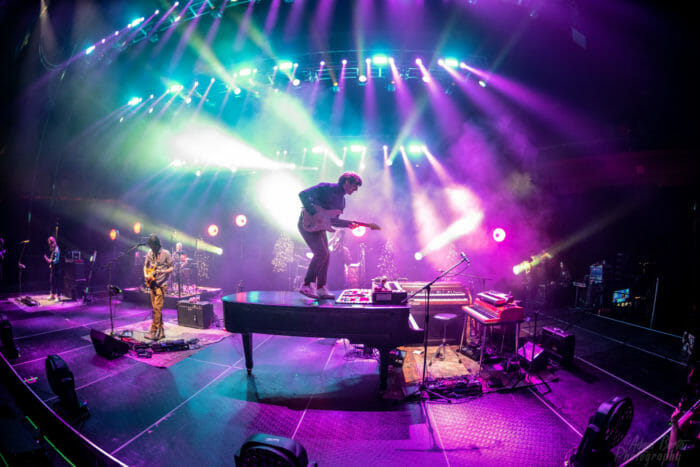
Anspach set a high bar for himself. When asked to name an early personal highlight on keys, he states, “It might not have been until the fall of 2019. We were on a very special tour that fall because it was the first time anyone had ever bought advance tickets to our shows and a lot of these small clubs had sold out. I remember we were playing in Columbus, Ohio and, during an “All I Need” jam, I went up to the synth and took a solo, which I had never really done. At that moment I was like, ‘Wow, I just took a synth solo.’’ He laughs then adds, “I still love that recording.”
Looking back at the decision to invite Anspach into the fold, Mitarotonda recalls that it came to him in something of an epiphany.
“I was on an exercise bike in my mom’s garage, pedaling super hard and sweating, while trying to gain clarity on our situation and, all of a sudden, I had this vision that Peter Anspach needed to join the band,” he recounts. “It was a very left-field thing because we needed a keyboard player, not a guitar player, and he was the leader of his own band. But at the time, I was looking for that excitement of playing music in the basement when you’re a kid while your parents are trying to go to sleep. I was looking for the magic and wonder that comes with the discovery of music. Then, when we crossed paths with Great Blue, that’s what I saw. I was like, ‘Shit, I want to go with you guys. This seems way more fun.’ So our sands were shifting pretty heavily.
“We were playing with some really great musicians but it’s a matter of chemistry and finding the right person who gets what you’re trying to do. I remember there was a moment when we first harmonized together. Everyone’s got a unique phrasing in the way that they deliver melodies, and it can be hard to connect. But I remember, with Peter, he got it right away and it seemed pretty effortless.
“Sometimes things work for a while and then, for whatever reason, they don’t feel good anymore. That’s certainly true of songs, which might need a change here, a change there, or a completely new feel. It’s constant tinkering and maintenance to make each thing feel fresh, exciting and alive.”
***
Dripfield is a blend of new material and new takes on older songs. It embodies the Goose ethos of remaining open-minded and forward-thinking, without casting aside the still-vibrant aspects of one’s past.
Two songs that experienced transformations in the studio, long after their live debuts, were Mitarotonda’s “Hot Tea,” which goes all the way back to the Vasudo days, and Anspach’s “The Whales.” Goodwin explains, “Those are two that I felt the J.J. Cale juju on. I wanted them to feel fun, to invoke some of the live band stuff they do so well, and wanted them to feel a bit ramshackle, without having extended solos and such.”
Atkind notes, “When we play ‘Hot Tea’ live it is a banger. By the end, we’re going crazy. Rick is shredding; I’m on the bell of the ride cymbal. It’s full energy. When we took that into the studio, we tried to channel this cool, relaxed energy instead of that other vibe. It’s still the same song, but there’s definitely a little bit of a different attitude to it.”
Mitarotonda describes it as “hot tub drug funk” or “Pulp Fiction drug funk” where “there’s a bunch of people casually hanging out and grooving—kicking back in the hot tub and just letting the funk go.”
Anspach echoes Goodwin’s J.J. Cale reference point for “The Whales” and suggests, “It’s got almost a bluegrass feel to it. We threw in so many acoustic guitars and strings. There’s even a take that almost sounds like mandolin, but it’s Rick playing the entire take above the 12th fret on an acoustic guitar. We were bringing in all these cool elements to the track.”
Goodwin points to Mitarotonda’s guitar solo on “Slow Ready,” another song that had been around for a couple years, as a highlight. “I basically hooked Rick up with an old Mu-Tron pedal and one of my weird guitars, and he had no idea what was about to happen. He played one of my favorite solos of the last decade.”
Mitarotonda’s “Arrow” is another tune Goose previously performed live that took on new colors in the studio. Goodwin identifies it as the first song that sparked a connection with him.
“I was excited about the many worlds it could inhabit,” he says. “The big one was evoking Fela Kuti in the main verse sections, juxtaposed against the weightlessness of the chorus. I wanted it to feel like zero gravity, as if the floor was just removed from under your feet, and then you were surrounded by this lush and deep soundscape. It was such a stark contrast against the funky and more aggressive verses. And then I wanted the feeling of being jettisoned back into the main song as if you were on a slingshot.”
Anspach’s new “Moonrise”—an ode to Wes Anderson’s Moonrise Kingdom—is something of a surprise. “Moonrise” wouldn’t feel out of place in another classic film, Mike Nichols’ The Graduate, which features a soundtrack by Simon & Garfunkel. Anspach notes, “It was just Rick, Jeff and I tracking the song and Jeff played upright bass. We did a couple of takes all the way through and it was such a simple recording process. It’s a live take and then I overdubbed some piano and a harmony vocal. That was it. Dan did such a good job of saying, ‘Let’s just keep it simple.’” Goodwin adds, “It’s a very nostalgic song to me.”
Goose’s ongoing evolution is represented by the first three songs on the album: “Borne,” “Hungersite” and “Dripfield.” They are nuanced offerings that unfold and reveal themselves in the moment. Mitarotonda contributed the first two as well as the lyrics to the third, which emerged out of a jam that the band performed during a soundcheck for one of their Bingo Tour livestreams during the pandemic.
These songs also reflect an approach that has animated Mitarotonda over recent years. He explains, “I have gravitated toward music that is much more impressionistic. Sometimes the lyrics are barely audible or they’re just sounds. But, at the same time, there’s a fair amount of intent, so there is almost like an extra hidden layer of complexity and beauty. It’s more visceral, more like a feeling, and it takes me out of rational thought. I think that, in this day and age, getting out of our heads collectively to become more present is such a cool thing.
“Justin Vernon is probably the most extreme example of that. His music has had a massive impact on me. Gregory Alan Isakov, although very different, could also fall into that category in his own way. He’s such a brilliant lyricist. There’s sort of this crossover in my mind between these free/ impressionistic approaches and artists that have their unique and potent ways of creating and maintaining this sense of mystery in their words. Thom Yorke definitely exists there to me, the band Poliça comes to mind and the first couple Fleet Foxes records opened a lot of doors for me on this topic. The first Alt-J record is also right at the top of my favorite lyrical works. Certain popular indie music has had the most impact on me in recent years; coming from where I was coming from, some of that stuff has seemed so interesting and creatively explosive.”
Indeed, as Goose continues to move forward, Goodwin observes, “I feel like both Rick and Peter are writing more broadly now and, after this record, they realize that they don’t have to fit a mold. They’re obviously all incredible players, but the magic of the band really is in the improvisation. So, for me, it’s fun to see the new material dive into that sort of experimentation, while also being song-based. I think it’s a fine balancing act, but I’m hoping to see it grow.”
***
Growth is on the horizon for goose in a variety of contexts.
On the night that Mitarotonda and Atkind spoke for this piece, the band’s music appeared during the ESPN broadcast of the NHL playoff game between the Calgary Flames and the Edmonton Oilers.
After Dripfield is released on June 24, one can anticipate that Goose’s songs will surface in additional unanticipated settings.
So, too, the group will continue to build a fanbase that connects with the quintet’s aspiration of remaining true and in the moment with its improvisation, with its creative pursuits and even with its humor. (One recent example: When Goose performed on Groundhog Day at the Midtown Ballroom in Bend, Ore., the band members walked onstage in the same manner, said the same things and performed the same song, “Tribute to Gold,” while opening two sets and an encore, as a nod to the film Groundhog Day.)
As he contemplates the group’s upcoming appearance at Radio City, Atkind looks back to January 2018: “I’ll never forget when we opened those seven shows for Spafford. At every one of those shows, there was this couple, Mike and Jess, who were on the rail first every time. Since we were the opening band, they saw our set. Then, all of a sudden, we had this couple that, if we were within 10 hours of where they lived, they would be there. It’s reassuring when you’re doing something that can be a grind, to see people who make the effort to support you. It’s mind-blowing, humbling and inspiring.”
“I don’t know what it’s going to feel like playing on that stage,” Anspach adds. “I’ve been there a few times. I saw the Rockettes and I saw Tame Impala. It’s incredible to be able to play there, and I’m so grateful for everybody who has supported us by buying a ticket right away, allowing us to add a second night. Holy cow! That means that we can go in and maybe even get a little more comfortable. I never expected any of this to happen when I joined the band or at all in my lifetime.”
Meanwhile, even as Goose moves into larger and more prestigious venues like Radio City, Mitarotonda affirms that his goal “is to express myself the same way that I would if I were alone with the band in a room. The challenge is closing the gap as much as possible between how you would express yourself with no one watching and with however many people are watching. The smaller that gap, the better.”
And whatever the context may be, “I just want to travel to distant star systems.”




